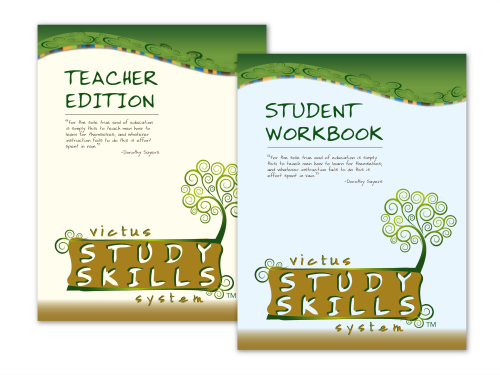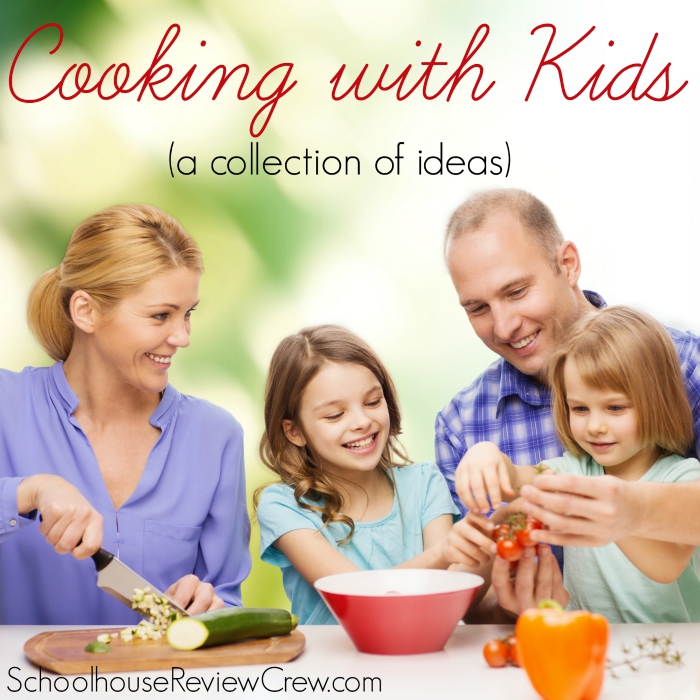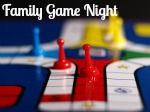Learning is a really exciting venture. I am still learning on a daily basis, and one of my favorite things about homeschooling is the challenge of staying on the cutting edge of so many different topics. I mean, isn't that one of the most common questions asked of any homeschool parent? How are you able to teach so many different subjects? Really, the fact is that while I have a good grasp on the basics of many areas, often the reality is that I am either in the process of learning or refreshing most topics on a regular basis, trying to equip for daily schooling and for life!
We were given the opportunity to review the
Victus Study Skills System through
The Old Schoolhouse Review Crew. For this review, we were given the
Teacher Edition and Student Workbook to work through. Since this system is recommended for grade 5-12, I decided to use it with Melissa, my 7th grader. We are in the middle of planning out her high school agenda and making that transition from elementary levels to high school levels in several areas, so I thought this would be a perfect time to introduce some study skills and life planning to round out her junior high experience.
What is the Victus Study Skills System? It is a short course that aims to teach students how to be a success in learning. To that end, the aim is to equip them not only with good study skills, but also a successful way of thinking about their goals and priorities. Often we leave students to flounder around and 'figure it out' when it comes to studying or planning for the future. The goal of this course is to help the student answer three basic questions:
Where are you now?
Where do you want to be?
How do you get there?

The concepts I found in this course are sound principles that lay out a groundwork for an actual strategy for students to learn and plan for their future. The emphasis really is on teaching the student to take ownership of their studies, and involving them in figuring out what their learning style is, while learning specific ways to be a success with that particular learning style.
What does "Victus" mean? "Victus" is Latin for "way of life", and the emphasis I found while going through this course is that learning is an attitude that we must develop in our students. Just as I am still learning new things everyday, even though I have been out of 'school' officially (in a student capacity) for many years, our students must grasp on to that willingness to always be striving to add to their knowledge. We never stop learning. It truly must become a way of life.
How is the course laid out? The teacher edition contains the concepts, as well as ideas for the teacher to teach the lessons to their students. Most of the student pages are included in the teacher edition, with answers filled in where applicable. There is a good deal of information in the front of the teacher edition that includes the course objectives and philosophy.
How long does the course take to complete? The course is ten lessons long. There is a suggested outline that instructs the teacher to complete the course in five sessions. A teacher also can stretch the sessions out to cover one lesson per day, over ten days. Lessons can take 15-30 minutes each, depending on how much discussion the teacher and student have.
What does the student do? There are plenty of exercises to help the student actually think through and write down goals and personal examples. The exercises are meant to reinforce the concepts that the teacher taught. Older students could work through the lessons on their own, reading and completing the exercises, although I feel that these concepts are best grasped when taught in a 'mentoring' and instructing style.
What else is included? Besides the learning style activities and personal goals exercises, the remainder of the book focuses on answering the "How do you get there?" question. The course thoroughly teaches study skills, test taking skills, listening skills, and note taking skills. It teaches a studying system called "PQRST" which stands for preview, question, read, state, and test. How wonderful it is to actually teach a student an effective method to study!
Who is this for? I believe any student could benefit from the structure of this program. Homeschooled students definitely could benefit from learning note taking, studying skills, and test taking skills, since they will not have as much exposure to these areas as their traditionally schooled peers. That being said, I know that both myself and my husband, who both attended traditional schools, never learned many of these concepts, and it was a hindrance that we had to struggle to overcome.
How did we use this program? As I mentioned, I taught the course to Melissa. I used the teacher edition to learn the lessons myself, then taught the concepts to her as best as I could. Some of the exercises we did together, some she did on her own, and some are still a work in progress. (There is an exercise that has the student list goals for spring, summer, and fall. Melissa is currently working on spring and summer goals, and we will revisit fall goals at a later date).
Through this program, Melissa learned that she is mostly a visual learner with a strong dose of kinesthetic style as well. I had her go through the skill set for those two learning styles and choose three goals that she will work on that will compliment her learning style well, while she is completing schoolwork.
I would like to share one of the exercises Melissa completed that helped her see where she is at now, and what some of her future goals might be. This simple drawing invoked a great discussion and really opened her eyes to how quickly life passes on, and how important it is to take it seriously.
Five years ago, she liked to play make believe and dolls, now she likes to play sports, five years from now she will be graduating, and ten years from now, she might be going to college or working with orphans!
How this course affected us: I found that as a 7th grader, Melissa has not spent a great deal of time pondering the three questions that the book presents, especially "where am I going? and how to get there?". I feel this book has been a real eye opener to help her take life (and her studies) more seriously. At first, she was kind of resistant to really delving into some of these topics, because I just don't think she understood the relevancy of how it applied to her, or how it could help her. We sat down and took the learning style test together, and once she saw that her and I made almost the same choices and have similar learning styles, she was drawn in. When we really started discussing how proper study skills could help her be a success and reach her goals, she became much more interested.
What I really like: I love the practicality of the concepts. They are so relevant to daily living. I also liked that the course is not just all about "how to study" more efficiently, but also expands to discuss goals and priorities of daily life. Melissa was able to see that she spends more time on 'relaxation' than she thought she did, and she now has the tools and understanding to possibly make some changes in her daily priorities in order to attain better goals. Doing this course together with Melissa has afforded me some great opportunities for discussions about her life and goals that we probably would not have otherwise had.
What I wish I could improve: I would love to see a simpler layout for the teacher. I would like to see the concepts presented, perhaps in an outline form, at the beginning of each lesson. (Perhaps that is just my learning style!) :-) Also, I would really like it if the teacher edition had each student page in it. It had most, and definitely had the ones that had answer blanks, but I found myself going back and forth a lot between the student and teacher editions to see what I was missing.
On the website: While I was researching the products on the website, I found that there are videos and
other learning materials to be used in conjunction with the teacher and student editions. I think perhaps the video might be very helpful. At times I felt I was not teaching the lesson thoroughly enough, just from the material in the teacher edition alone. I think the video lessons would definitely fill in the gaps that were missing from my instruction.
What does this cost? The teacher edition currently sells for $40 and the student edition currently sells for $20.
Find out what my Crew mates thought of Victus Study Skills System, and how they used it with their children, by clicking the banner below:

Copyright 2012-2014 - "Be The One" - www.aclassofone.blogspot.com All rights are reserved. No text, photos, or content may be reproduced without direct permission from the author.

 Each of the stories, while using fictional names, are based on real life missionary stories. Some of the topics touched on include witnessing in Muslim countries, Bible smuggling, rescuing children in slave trades, and searching for Mayan treasures. All the while, listeners are experiencing a fun family atmosphere and learning about new topics. There is so much information incorporated into the stories - everything from famous people, character building, geography, vocabulary, and historical facts. I was amazed at how much information and excitement was packed into each story! There is even an episode that teaches what an "Epi-pen" is used for, when the dad has an allergic reaction to bee stings! (Being an allergy family, that caught my attention!) Stories take place all over the world: China, Mexico, Belize, and even a fictitious middle Eastern country called Bazakistan!
Each of the stories, while using fictional names, are based on real life missionary stories. Some of the topics touched on include witnessing in Muslim countries, Bible smuggling, rescuing children in slave trades, and searching for Mayan treasures. All the while, listeners are experiencing a fun family atmosphere and learning about new topics. There is so much information incorporated into the stories - everything from famous people, character building, geography, vocabulary, and historical facts. I was amazed at how much information and excitement was packed into each story! There is even an episode that teaches what an "Epi-pen" is used for, when the dad has an allergic reaction to bee stings! (Being an allergy family, that caught my attention!) Stories take place all over the world: China, Mexico, Belize, and even a fictitious middle Eastern country called Bazakistan!

 Overall, I think I would actually recommend this book to mothers mostly, as I think it could make a fine devotional to help them see the end result when some behaviors are allowed to continue and grow, molding a child's character. I do think, with some guidance and discussion, that children can also learn to examine their own hearts and lives through the instruction given in this book as well.
Overall, I think I would actually recommend this book to mothers mostly, as I think it could make a fine devotional to help them see the end result when some behaviors are allowed to continue and grow, molding a child's character. I do think, with some guidance and discussion, that children can also learn to examine their own hearts and lives through the instruction given in this book as well.


 Each episode lasts about 30 minutes, and the DVD combo packs have 3 different topics included, for 90 minutes of viewing time. The shows move along quickly, and are very well done with enthusiastic people, close up shots of amazing things, and plenty of catchy music and graphics. They thoroughly explore the topics, whether it is showing video of cool animals or food harvesting. The host, Joel Greene, totally immerses himself into the show by taking on the role of a person who is learning right alongside the viewers. Whether he is harvesting mushrooms, picking oranges, or feeding penguins, he keeps up a funny and entertaining non-stop dialogue throughout the show, with plenty of high energy enthusiasm.
Each episode lasts about 30 minutes, and the DVD combo packs have 3 different topics included, for 90 minutes of viewing time. The shows move along quickly, and are very well done with enthusiastic people, close up shots of amazing things, and plenty of catchy music and graphics. They thoroughly explore the topics, whether it is showing video of cool animals or food harvesting. The host, Joel Greene, totally immerses himself into the show by taking on the role of a person who is learning right alongside the viewers. Whether he is harvesting mushrooms, picking oranges, or feeding penguins, he keeps up a funny and entertaining non-stop dialogue throughout the show, with plenty of high energy enthusiasm. What did we learn about? On the Produce DVD Combo Pack we learned that cranberries are harvested by flooding their field! The girls were "grossed out" by the mushroom growing process, and they were amazed at how much work it is to pick and harvest oranges! On the Swimmers of the Sea Combo Pack the girls were thrilled to watch and learn about penguins, sea turtles, and salmon. The highlights of these shows were when Joel Greene had to feed the penguins, and of course, seeing the baby sea turtles. The girls laughed so hard over the children demonstrating the sounds a penguin makes, and they were amazed that people work so hard to move the salmon to the right locations so they can continue their life cycles even when nature has made this difficult.
What did we learn about? On the Produce DVD Combo Pack we learned that cranberries are harvested by flooding their field! The girls were "grossed out" by the mushroom growing process, and they were amazed at how much work it is to pick and harvest oranges! On the Swimmers of the Sea Combo Pack the girls were thrilled to watch and learn about penguins, sea turtles, and salmon. The highlights of these shows were when Joel Greene had to feed the penguins, and of course, seeing the baby sea turtles. The girls laughed so hard over the children demonstrating the sounds a penguin makes, and they were amazed that people work so hard to move the salmon to the right locations so they can continue their life cycles even when nature has made this difficult.

 What does a typical lesson look like? When a unit is selected, there are several different resources available. Since I have used this program with two very different children, I was able to see that not everything needs to be done in the same order. A typical lesson has introductory materials, both reading and video. MP3 downloads are also available. There will be a list of needed supplies for the experiments (which are mostly items you will find around the house, with the exception of some of the more intricate chemistry and electronics supplies), as well as pdf lessons to download for the student to complete. Depending on the student, some like to watch the videos first and see what happens, before completing the experiments and working through the worksheets. Others like to study the concepts first through the worksheets and reading, then complete the experiments afterwards. This program allows the flexibility for you as a parent to figure out what method works best for your own children.
What does a typical lesson look like? When a unit is selected, there are several different resources available. Since I have used this program with two very different children, I was able to see that not everything needs to be done in the same order. A typical lesson has introductory materials, both reading and video. MP3 downloads are also available. There will be a list of needed supplies for the experiments (which are mostly items you will find around the house, with the exception of some of the more intricate chemistry and electronics supplies), as well as pdf lessons to download for the student to complete. Depending on the student, some like to watch the videos first and see what happens, before completing the experiments and working through the worksheets. Others like to study the concepts first through the worksheets and reading, then complete the experiments afterwards. This program allows the flexibility for you as a parent to figure out what method works best for your own children. 


 The concepts I found in this course are sound principles that lay out a groundwork for an actual strategy for students to learn and plan for their future. The emphasis really is on teaching the student to take ownership of their studies, and involving them in figuring out what their learning style is, while learning specific ways to be a success with that particular learning style.
The concepts I found in this course are sound principles that lay out a groundwork for an actual strategy for students to learn and plan for their future. The emphasis really is on teaching the student to take ownership of their studies, and involving them in figuring out what their learning style is, while learning specific ways to be a success with that particular learning style. 

